Hamsters are by far the most popular pet rodent in the world. These tiny rodents make good pocket pets for both children and adults alike. Hamsters are renowned for their adorable appearance, peaceful temperaments, and small size. They are a 2-to-3-year commitment and need a responsible owner that can meet their care requirements.
With so much outdated care information out there, we decided to create this article with the intent to show you what proper hamster care entails. Here’s everything you need to know.
The 5 Different Species of Domestic Hamsters
Before we discuss the care requirements of hamsters, it’s important to understand the different species that are kept as pets. There are around 19 different species of hamsters, but only 5 of them are domesticated.
1. The Syrian Hamster
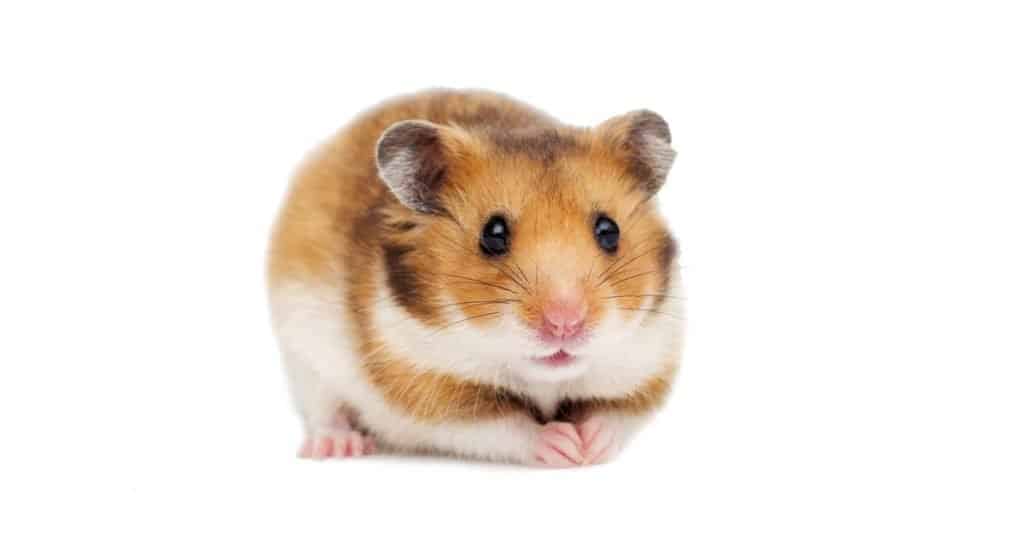
The Syrian is the largest species of domesticated hamster.
©Happy monkey/Shutterstock.com
| Scientific name: | Mesocricetus auratus |
| Size (adult): | 5 – 8 inches; 5 – 7 ounces |
| Lifespan: | 2 – 3 years |
The largest and most commonly kept species of hamster is the Syrian or Golden hamster. They are often sold under the name teddy bear or fancy bear hamster in pet stores, which refers to the same species of hamster.
Syrian hamsters can be distinguished for their large size, which ranges from 5 to 8 inches as an adult. They have been bred in captivity for over 80 years and are the first species of hamster to ever be domesticated. The origins of the Syrian hamster date back to the 1700s in Syria, when they were mentioned in a second edition of a book detailed by physician Alexander Russell’s younger brother, Patrick Russell. It wasn’t until the 1930s that the first Syrian hamster would be captured from the wild and start its journey to domestication.
Syrian hamsters can now be found all over the world as pets, and they are arguably the most popular species of hamster. They can be found in most coat varieties, with either a long or short coat found in endless colors and patterns.
2. The Campbell’s Dwarf Hamster
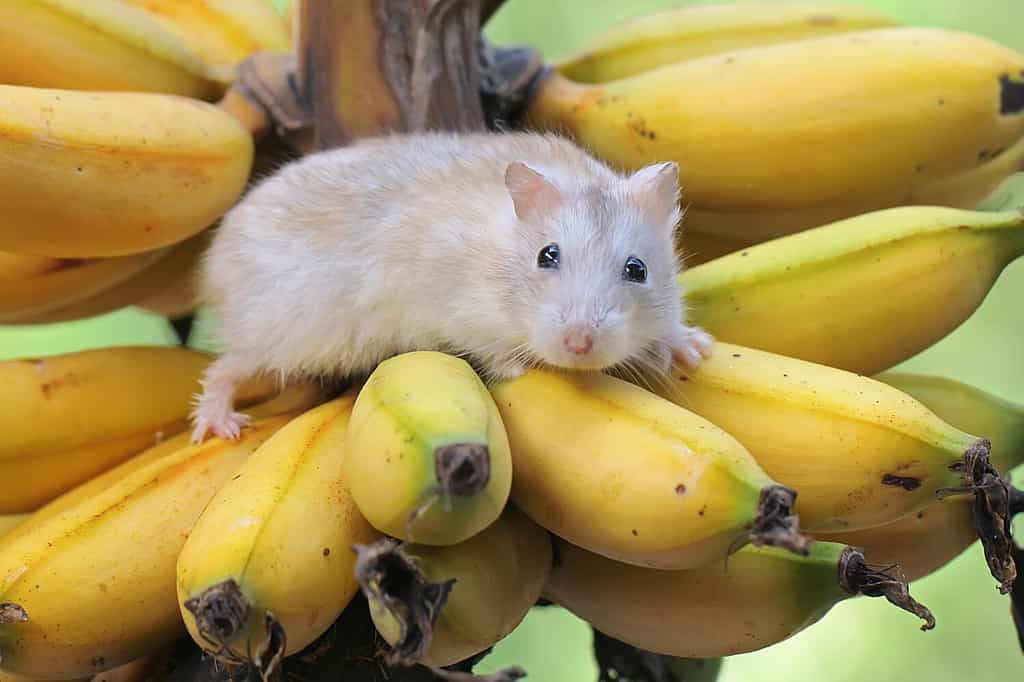
Campbell dwarf hamsters can be found in many different colors.
©I Wayan Sumatika/Shutterstock.com
| Scientific name: | Phodopus campbelli |
| Size (adult): | 2 – 4 inches, 1 – 2 ounces |
| Lifespan: | 2 – 3 years |
The second most popular species is the Campbell’s dwarf hamster. They were discovered in 1902 in Mongolia and named after their collector, W.C Campbell. The Campbells dwarf hamster has a relatively small size at only 2 to 4 inches long. Campbell’s dwarf hamsters have a relatively mellow and docile temperament, and they enjoy being handled after taming.
Their wild color form consisting of grey and white with a dark dorsal stripe happens to be their most common coloration in captivity. However, they can be found in other color forms like black, blue fawn, beige, dove, and even opal. This is considerably more colors than other dwarf hamsters, but still fewer than Syrian hamsters.
3. The Winter White Dwarf Hamster
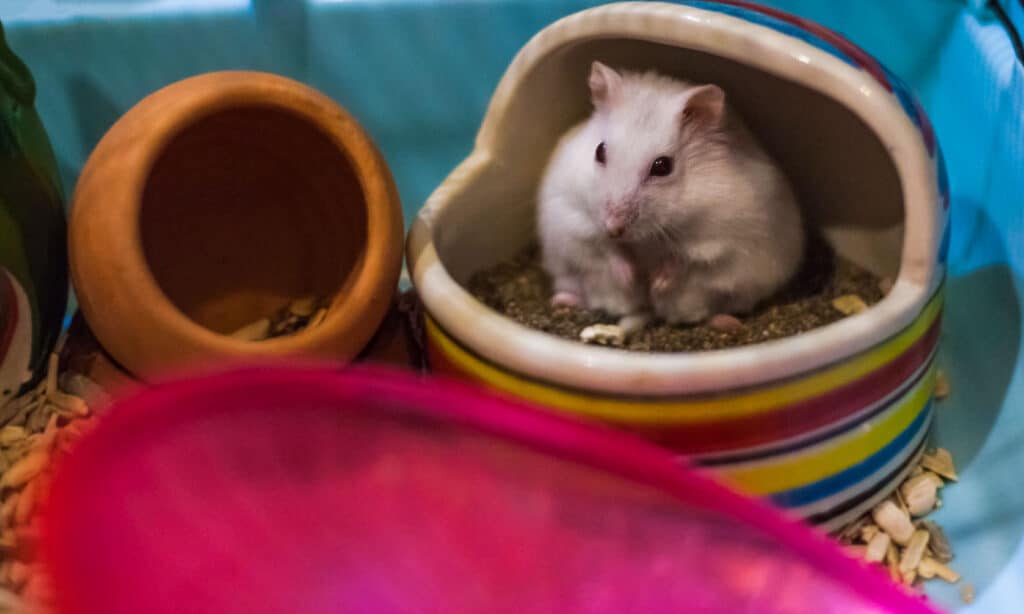
Winter white hamsters may change their coat color in response to shorter daylight hours and extremely cold temperatures.
©iStock.com/Vichai Phububphapan
| Scientific name: | Phodopus sungorus |
| Size (adult): | 2 – 4 inches; 1 – 2 ounces |
| Lifespan: | 2 – 3 years |
The second species of dwarf hamster is the winter white hamster, sometimes called the Djungarian hamster. They originate from eastern Kazakhstan and the grassy steppes of Siberia. The temperature in their natural habitat can drop to a low -4 degrees Fahrenheit. Instead of hibernating, the winter white hamster burrows deep into the ground and forms a series of tunnels that they use to escape the cold.
Interestingly, this species of hamster is named after their ability to change the color of their coat during the cold winter months. Although they keep their thick dorsal stripe, they develop a thick whiteish-grey coat in winter. However, since most homes do not get very cold in winter, some winter white hamsters do not go through this color transition.
4. The Roborovski Hamster
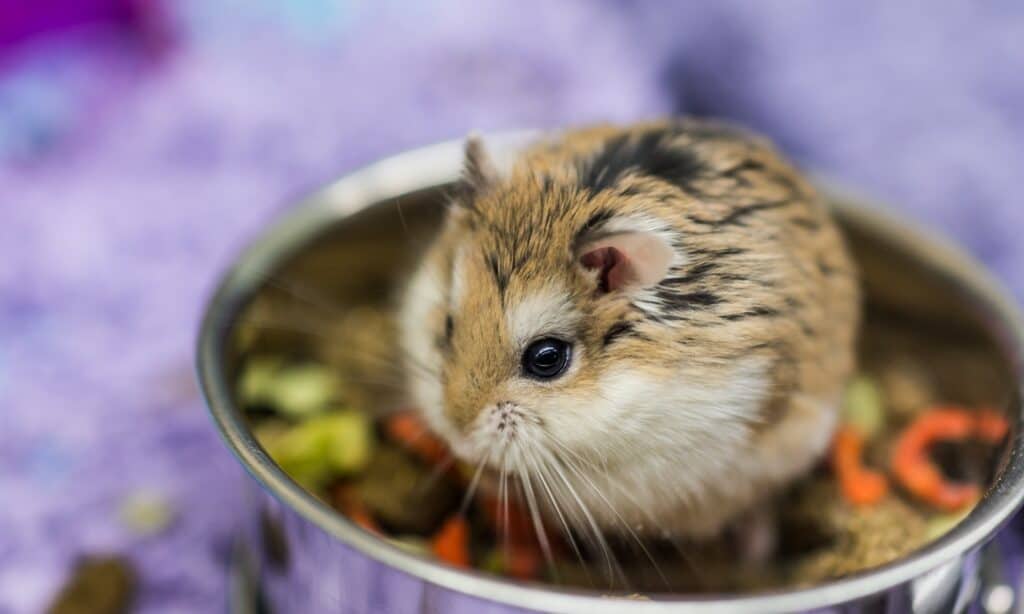
The Roborovski is the smallest species of hamster.
©iStock.com/krblokhin
| Scientific name: | Phodopus roborovskii |
| Size (adult): | 1.5 – 3 inches; 0.5 – 1 ounce |
| Lifespan: | 2 – 3 years |
The smallest species of domesticated hamster is the Roborovski or robo for short. These tiny hamsters only reach a size of 1.5 to 3 inches, which is slightly smaller than most dwarf hamsters. Roborovski hamsters can be found throughout the Mongolian deserts and have only been in captivity since 1970.
Due to their small size, some children and adults might find the Roborovski hamster challenging to handle. They seem to have a more timid temperament than the other species and are very fast.
They can be found in different color forms like husky, platinum, and agouti, although not nearly as many as the Syrian or Campbell’s dwarf hamster.
5. The Chinese Hamster

Chinese hamsters can be distinguished by their longer tails.
©Allocricetulus/Shutterstock.com
| Scientific name: | Cricetulus griseus |
| Size (adult): | 3 – 5 inches; 1 – 2 ounces |
| Lifespan: | 2 – 3 years |
The fifth species is the Chinese hamster, which can be distinguished by their almost mouse-like appearance. Chinese hamsters originate from the deserts and rocky terrain of Mongolia and China. They aren’t as tolerating of the cold as winter white hamsters, and they are slightly larger than both Roborovski and dwarf hamsters.
Chinese hamsters can be distinguished by their long tails which is around three times the length of the Syrian hamster. They are agile climbers and enjoy cages with low levels, ladders, and enrichment items to climb over. Chinese hamsters are not as common as the other hamster species, although they have been domesticated for quite some time.
Although rare, Chinese hamsters can be found in other color forms than the standard grey-brown. You can find them in spotted white and black-eyed white too.
About Hybrid Dwarf Hamsters
Most pet dwarf hamsters are not a pure species of hamster. Instead, they are a hybrid between the two dwarf hamster species – the winter white and Campbell hamsters.
It is very rare to find a pure Campbell or winter white dwarf hamster these days. They can be purchased from certain breeders, although you will need to check their breeding papers to determine if they truly are purebred hamsters.
Hybrid dwarf hamsters are strictly solitary and should never be housed with another hamster once they mature. They have the same average lifespan, care requirements, and size as the Campbell and winter white dwarf hamsters.
Some hybrid dwarf hamsters have more physical traits of either the Campbell or winter white, but that still doesn’t mean they are purebred dwarf hamsters.
Pet Care: Essential Care Tips for Housing, Feeding, and Enrichment
Despite their popularity, many people do not fully understand the care requirements of hamsters. They are often housed incorrectly in tiny cages with unsuitable bedding and diets. Many of the incorrect supplies and cages marketed towards hamsters are still found in pet stores, despite recent research showing that they are outdated and even cruel.
Caring for a hamster is a commitment and responsibility to provide them with the right sized cage, diet, enrichment, and veterinary care.
Housing Hamsters

Pet stores often sell cages that are way too small for hamsters. They should only be used for travel purposes, and not as a permanent home.
©BearFotos/Shutterstock.com
All hamsters require a spacious cage that meets or exceeds the minimum dimensions. The small wired cages with brightly colored tunnels and ramps are not a proper form of housing for hamsters. They are often tiny and rarely provide hamsters with enough space for roaming and basic supplies. These small cages should never be a hamster’s permanent home, even though pet stores still sell them and consider them safe. You are better off using them as travel cages and keeping your hamster in a proper cage instead.
Below is a basic guideline of the minimum cage sizes recommended for hamsters.
- Syrian hamster: 40 × 22.5 × 24 inches (900 sq. inches of floor space).
- Other species of hamster: 40 × 17.5 × 24 inches (700 sq. inches of floor space).
Since Syrian hamsters are the largest species, they will require slightly larger cages than dwarf and Chinese hamsters. Keep in mind that hamsters need continuous floor space and not multiple levels. Unlike rats, hamsters are not good climbers and prefer to stay on leveled ground and do not benefit from multiple levels in their cage.
Finding The Right Cage for Your Hamster
With the majority of pet store cages being unsuitable for hamsters, you have a few appropriate housing options to choose from.
Bin cages: These are large storage tubs (over 700 sq. inches) that are converted into hamster cages. They are a simple, safe, and affordable form of housing for all species of hamsters. The tub should be at least 24 inches deep to ensure that your hamster cannot escape easily. You will need to cut out and install a wire mesh grid in the lid of the tub to promote airflow throughout the base and prevent your hamster from escaping.
Fish tanks: Both glass and acrylic fish tanks can be made into a spacious home for your hamster. You ideally want a rectangular tank above 40 gallons in size, since any sizes below that are too small. A wire mesh lid will need to be made to cover the top of the fish tank, otherwise, your hamster could escape.
Rabbit or guinea pig cages: Some very large rabbit or guinea pig cages can function as a hamster cages. However, you may need to cover the bars with a wire mesh to prevent your hamster from escaping. The bars of rabbit and guinea pig cages are usually wide enough for both Syrians and dwarf hamsters to escape from.
Premade hamster cages: Even though pet stores don’t usually stock them, there are some appropriate size hamster cages available for sale.
They include the:
- Prevue 528 cage
- Living World deluxe habitat
- Niteangel aspen terrariums (medium or large version only)
- MidWest hamster nation home
- Amazon Basics small animal habitat
- Savic Sky Metra XL Hamster cage
- Ferplast Maxi Duna cage
Understanding a Hamsters Diet
Feeding your hamster a complete and nutritious diet is crucial for their health. Hamsters have evolved as omnivores to eat a varied diet consisting of both plant and animal-based ingredients. Their diet needs to be balanced and consists of various seeds, pellets, and a small portion of fresh fruits and vegetables.
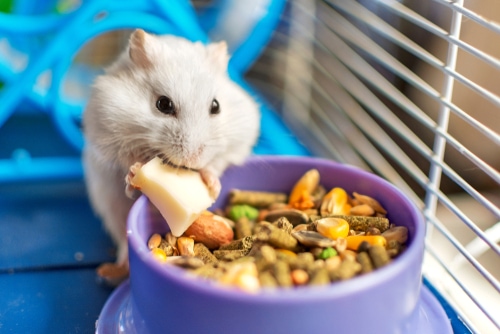
Hamsters are omnivores and enjoy a varied diet that meets their nutritional requirements.
©RaquelVizcaino/Shutterstock.com
A hamster should get most of their nutrients from a pelleted food or seed mix. Fruits and vegetables should only be offered to hamsters as a healthy treat and should not form more than 5% of a hamster’s diet.
| Protein: | 16% – 21% |
| Fiber: | 8% – 12% |
| Fat: | 4% – 7% |
Many commercial hamster foods are not complete on their own. You may need to mix different hamster foods together to achieve a suitable guaranteed analysis for your hamster. For example, you can mix a high-quality hamster seed mix with pelleted food.
Some hamster foods are better quality than others, but you want to avoid foods that contain too much of a certain ingredient, like sunflower seeds or corn. Furthermore, certain brightly colored hamster pellets may look appealing, but they often contain dyes and colorants that do not benefit your hamster.
Keep in mind that hamsters are natural foragers and hoarders. They enjoy looking for their food and hoarding it in their cheek pouches to take back to their nest. Don’t be alarmed if you see your hamster store a lot of food at once. This behavior is normal, and hamsters do not eat all of this food at once.
Enrichment for Hamsters
Hamster enrichment consists of three essential things – deep bedding, chew toys, and wheels.
Deep Bedding
Hamsters do not necessarily play and instead like to explore their environment. As avid burrowers, hamsters require a deep layer of substrate to dig tunnels in. They will spend most of their time sleeping in these tunnels, and this is behavior they would display in the wild. You want to provide your hamster with a deep layer of bedding, ideally between 6 to 8 inches. Syrians benefit from slightly more bedding, at around 8 to 12 inches deep.
Not all hamster bedding is created equal. Some are safer than others, and some should not be used at all. The best hamster bedding that is recommended by hamster experts is any unscented paper-based bedding. This type of bedding is not only safe but holds burrows well and has good odor control. Alternatively, you can use hemp, aspen shavings, and coco peat as bedding.
You generally want to avoid any cedar or pine (even kiln-dried) shavings, nesting wool, newspaper, corncob, or scented bedding. Those types of bedding can be dangerous for hamsters and some even have toxic properties.
Chew Toys
A hamster’s teeth continuously grow throughout their life. They need various chew toys that they can use to wear their teeth down and keep them in good shape. You want to choose toys that are made from non-toxic materials and are not dangerous if your hamster ingests them. Wooden hamster chew toys are the safest option.
Exercise Wheels
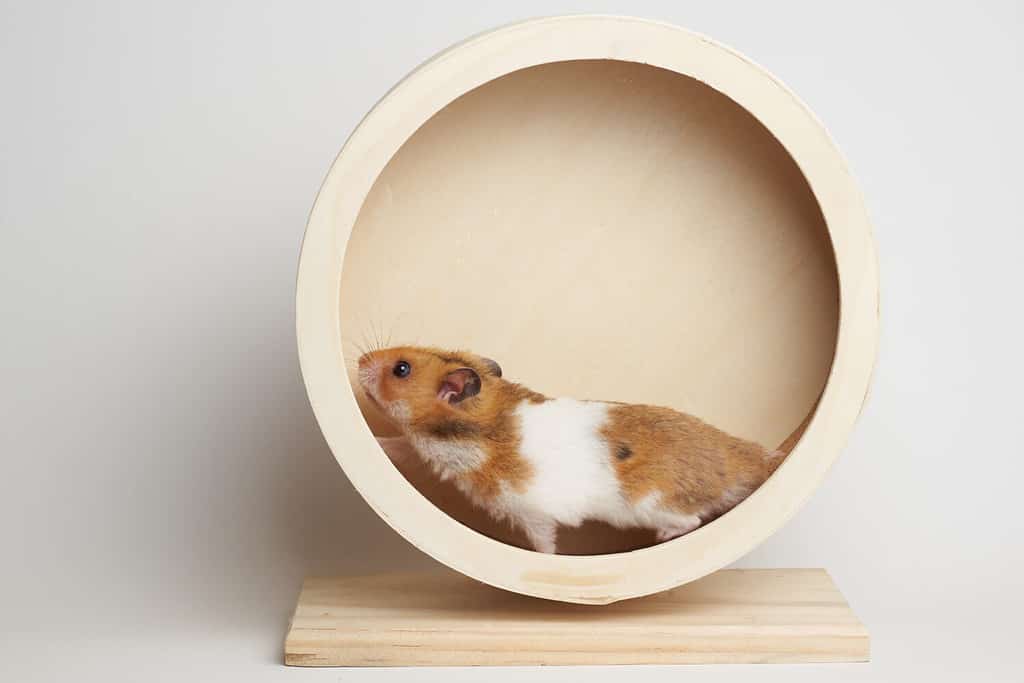
All hamsters need a flat exercise wheel to run on.
©Johannes Menge/Shutterstock.com
Hamsters are very active pets and benefit from having an exercise wheel in their cage. They can run up to 6 miles at night in the wild. Even if your hamster is kept in a spacious cage, they still need an exercise wheel. The wheel should have a flat, smooth surface rather than a barred or meshed bottom.
Syrian hamsters will need a larger wheel than dwarf or Chinese hamsters, with a diameter of 10 to 12 inches. Whereas the smaller species of hamsters can use an 8-to-12-inch wheel. The wheel needs to be big enough to ensure that your hamster’s back does not bend.
Lifespan: Understanding the Lifespan and Aging Process of These Small Creatures
Hamsters are very short-lived rodents that have an average lifespan of 2 to 3 years. There is no particular species of hamster that lives longer, and it is usually due to the individual hamsters’ genetics and care. Generally, a well-cared-for hamster that is kept in a spacious cage with safe bedding, a healthy diet, and access to medical care is going to outlive a poorly cared-for hamster.
Some hamsters can pass away suddenly usually with no explanation. This could be from an underlying medical condition or bad genetics. Hamsters are usually mass-bred to be supplied to pet stores, so little thought is given to their health and longevity.
Most hamsters are fully grown at 3 to 4 months of age. That is the age they will reach their adult size, although they would have sexually matured at 4 to 6 weeks.
At around 1 to 1.5 years old, most hamsters are considered seniors. They will visibly slow down and spend more time sleeping. You might notice that they use their wheel-less and don’t eat the same amount of food they used to. When a hamster is in their senior stage, it is important to keep them in a stress-free environment. You will need to do more frequent health checks since senior hamsters are prone to certain health problems like tumors.
Costs: Initial and Ongoing Costs
Although some might say that hamsters are cheap pets, many expert hamster owners disagree. Many of the proper supplies, food, and caging for hamsters can be pricey, especially when you first buy them. Fortunately, most of the expensive costs are initial, and the ongoing costs are much more affordable.
The initial costs for hamsters would be their cage, wheel, food bowl, water bottle, and certain cage accessories. The ongoing costs will be their food, chew toys, treats, bedding, and veterinary care. You can expect to spend around $345 to $650 for hamster supplies and caging when you first get them. Their ongoing costs vary between $30 to $50 per month.
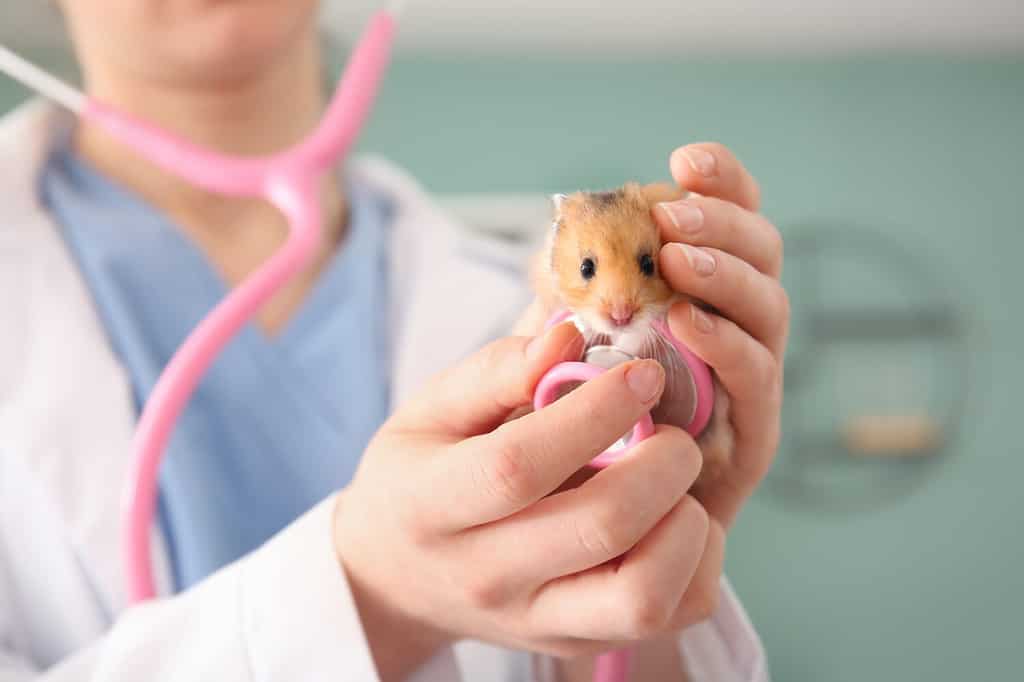
Hamsters need to be taken to an exotic veterinarian when they are sick or injured. Veterinary care is essential for these small and delicate rodents.
©Pixel-Shot/Shutterstock.com
When hamsters are ill or injured, they need to be taken to a veterinarian. This can be costly, especially if you do not have money saved for medical emergencies. A basic checkup at an exotic veterinarian can cost between $35 to $100. However, certain procedures and treatments can cost a few hundred dollars.
Important Facts: Key Information Every Hamster Owner Should Know
The following facts are important to know before getting a hamster.
- Hamsters are crepuscular and are most active during dawn and dusk. Some hamsters show more nocturnal characteristics, but all hamsters will sleep during the day. This means that you will need to handle a hamster at night to avoid disturbing them during the day. Aside from their care needs, this is one of the reasons they do not make good pets for small children.
- Stress in any form is not good for hamsters. These small rodents need a stress-free environment at all times. This is achievable by keeping them in proper-sized cages with a safe substrate, wheel, and a balanced diet.
- Most hamsters are solitary, especially Syrian hamsters who will fight to the death. Hamsters do not crave companionship and do well on their own. Keeping multiple hamsters together is also a risk for unwanted pregnancies. The average hamster litter is 4 to 8 pups, and hamsters can fall pregnant shortly after giving birth. Most hamster owners do not have the time, money, and space to breed hamsters. Also, many shelters and rescues are overwhelmed with unwanted hamsters, so breeding them isn’t recommended.
- Lastly, hamsters need to be taken to a veterinarian. Although they are short-lived pets, hamsters are just as deserving of medical care as a dog or cat. Before getting a hamster, be sure that you can afford to take them to an exotic veterinarian when necessary.

A baby hamster is called a pup.
©iStock.com/Mikhail Davidovich
Conclusion: Building a Happy and Healthy Relationship with Your Furry Friend
Although you might be overwhelmed with a hamster’s care requirements at first, you will start to see them thrive when you finally bring your new furry friend home. It can take a while for hamsters to warm up to their owners and enjoy being handled, but it is worth the wait. When provided with a spacious cage, proper diet, and enrichment, along with medical care, they can live out for the next 2 to 3 years in your care.
The photo featured at the top of this post is © Sharon Snider/Shutterstock.com
Thank you for reading! Have some feedback for us? Contact the AZ Animals editorial team.






